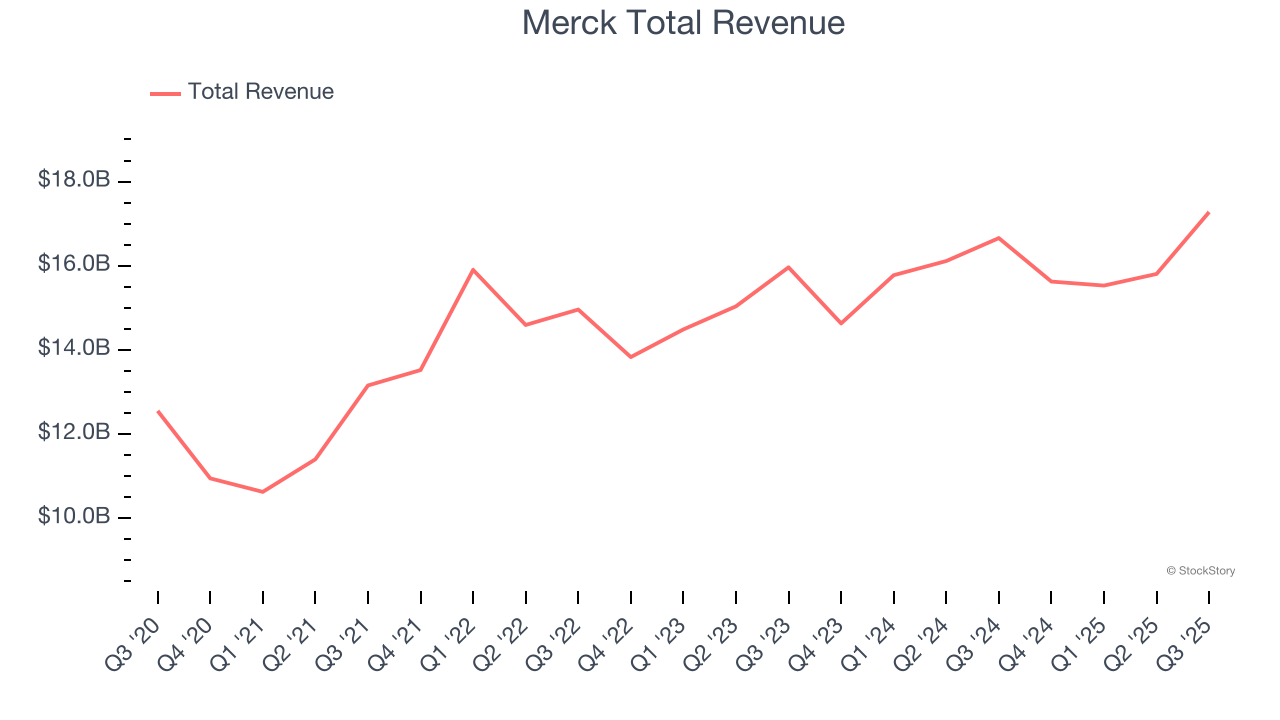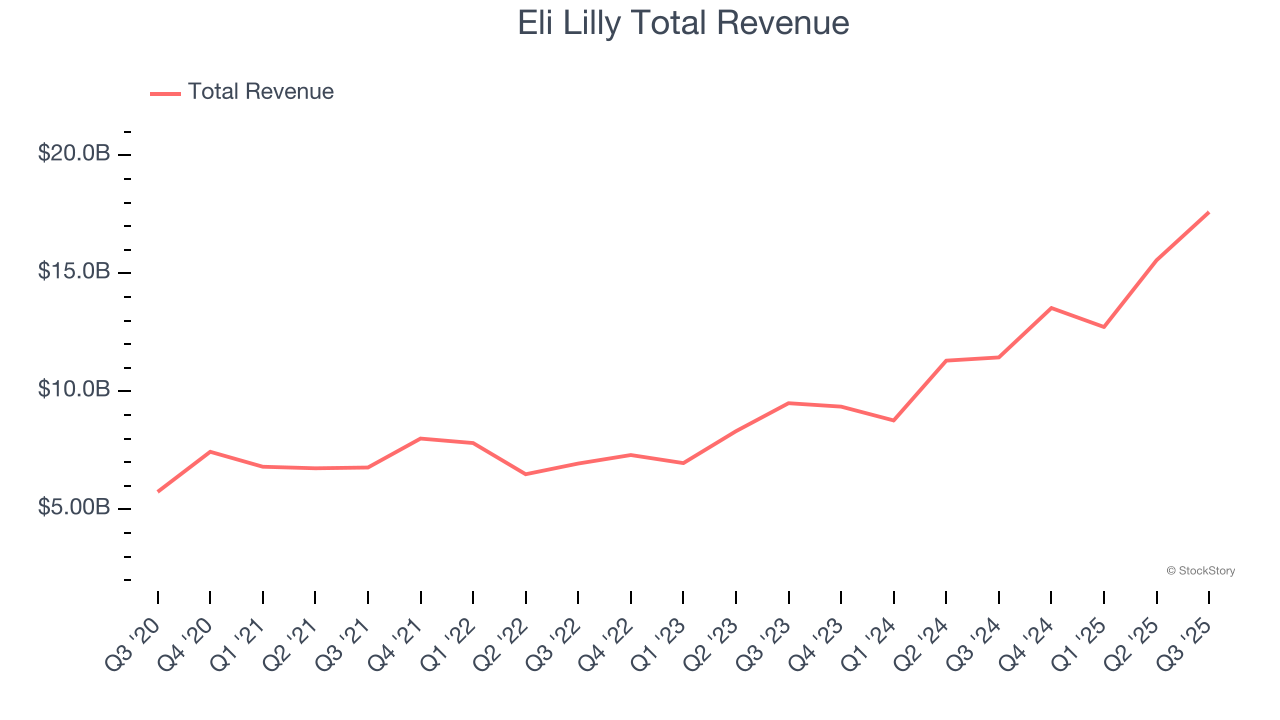|
|
|

|
|||||

|
|

Quarterly earnings results are a good time to check in on a company’s progress, especially compared to its peers in the same sector. Today we are looking at Merck (NYSE:MRK) and the best and worst performers in the branded pharmaceuticals industry.
Looking ahead, the branded pharmaceutical industry is positioned for tailwinds from advancements in precision medicine, increasing adoption of AI to enhance drug development efficiency, and growing global demand for treatments addressing chronic and rare diseases. However, headwinds include heightened regulatory scrutiny, pricing pressures from governments and insurers, and the looming patent cliffs for key blockbuster drugs. Patent cliffs bring about competition from generics, forcing branded pharmaceutical companies back to the drawing board to find the next big thing.
The 10 branded pharmaceuticals stocks we track reported a satisfactory Q3. As a group, revenues beat analysts’ consensus estimates by 2.3%.
Thankfully, share prices of the companies have been resilient as they are up 6.6% on average since the latest earnings results.
With roots dating back to 1891 and a portfolio that includes the blockbuster cancer immunotherapy Keytruda, Merck (NYSE:MRK) develops and sells prescription medicines, vaccines, and animal health products across oncology, infectious diseases, cardiovascular, and other therapeutic areas.
Merck reported revenues of $17.28 billion, up 3.7% year on year. This print exceeded analysts’ expectations by 1.7%. Overall, it was a strong quarter for the company with a solid beat of analysts’ constant currency revenue and EPS estimates.
“In the third quarter, we continued to execute on our strategy with important pipeline advancements, significant approvals and successful new product launches,” said Robert M. Davis, chairman and chief executive officer.

Interestingly, the stock is up 13.4% since reporting and currently trades at $98.19.
Founded in 1876 by a Civil War veteran and pharmacist frustrated with the poor quality of medicines, Eli Lilly (NYSE:LLY) discovers, develops, and manufactures pharmaceutical products for conditions including diabetes, obesity, cancer, immunological disorders, and neurological diseases.
Eli Lilly reported revenues of $17.6 billion, up 53.9% year on year, outperforming analysts’ expectations by 9.6%. The business had a stunning quarter with a solid beat of analysts’ revenue estimates and full-year revenue guidance exceeding analysts’ expectations.

Eli Lilly achieved the fastest revenue growth among its peers. The market seems happy with the results as the stock is up 30.6% since reporting. It currently trades at $1,060.
Is now the time to buy Eli Lilly? Access our full analysis of the earnings results here, it’s free for active Edge members.
Focusing on the powerful stress hormone that affects everything from metabolism to immune function, Corcept Therapeutics (NASDAQ:CORT) develops and markets medications that modulate cortisol to treat endocrine disorders, cancer, and neurological diseases.
Corcept reported revenues of $207.6 million, up 13.7% year on year, falling short of analysts’ expectations by 5%. It was a softer quarter as it posted full-year revenue guidance missing analysts’ expectations and a significant miss of analysts’ revenue estimates.
Corcept delivered the highest full-year guidance raise but had the weakest performance against analyst estimates in the group. Interestingly, the stock is up 11.7% since the results and currently trades at $79.39.
Read our full analysis of Corcept’s results here.
Pioneering a unique business model in the pharmaceutical industry since 1996, Royalty Pharma (NASDAQ:RPRX) acquires rights to receive portions of sales from successful biopharmaceutical products, providing funding to drug developers without conducting research itself.
Royalty Pharma reported revenues of $609.3 million, up 7.9% year on year. This result missed analysts’ expectations by 2.6%. Overall, it was a slower quarter as it also logged a significant miss of analysts’ revenue estimates.
The stock is up 2.9% since reporting and currently trades at $38.93.
Read our full, actionable report on Royalty Pharma here, it’s free for active Edge members.
With a diverse portfolio of eight FDA-approved medications targeting neurological conditions, Supernus Pharmaceuticals (NASDAQ:SUPN) develops and markets treatments for central nervous system disorders including epilepsy, ADHD, Parkinson's disease, and migraine.
Supernus Pharmaceuticals reported revenues of $192.1 million, up 9.3% year on year. This number surpassed analysts’ expectations by 3.5%. More broadly, it was a mixed quarter as it also recorded an impressive beat of analysts’ revenue estimates but a significant miss of analysts’ EPS estimates.
Supernus Pharmaceuticals had the weakest full-year guidance update among its peers. The stock is down 20.5% since reporting and currently trades at $45.32.
In response to the Fed’s rate hikes in 2022 and 2023, inflation has been gradually trending down from its post-pandemic peak, trending closer to the Fed’s 2% target. Despite higher borrowing costs, the economy has avoided flashing recessionary signals. This is the much-desired soft landing that many investors hoped for. The recent rate cuts (0.5% in September and 0.25% in November 2024) have bolstered the stock market, making 2024 a strong year for equities. Donald Trump’s presidential win in November sparked additional market gains, sending indices to record highs in the days following his victory. However, debates continue over possible tariffs and corporate tax adjustments, raising questions about economic stability in 2025.
Want to invest in winners with rock-solid fundamentals? Check out our Top 5 Growth Stocks and add them to your watchlist. These companies are poised for growth regardless of the political or macroeconomic climate.
StockStory’s analyst team — all seasoned professional investors — uses quantitative analysis and automation to deliver market-beating insights faster and with higher quality.
| 12 hours | |
| 12 hours |
Stock Market Today: Dow Rises As Nvidia Rebounds; Tesla Near Buy Point (Live Coverage)
MRK
Investor's Business Daily
|
| 12 hours | |
| Dec-14 | |
| Dec-12 | |
| Dec-12 | |
| Dec-12 | |
| Dec-12 | |
| Dec-12 | |
| Dec-11 | |
| Dec-11 | |
| Dec-11 | |
| Dec-11 | |
| Dec-10 | |
| Dec-10 |
Join thousands of traders who make more informed decisions with our premium features. Real-time quotes, advanced visualizations, backtesting, and much more.
Learn more about FINVIZ*Elite